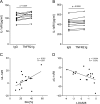Deficient spontaneous in vitro apoptosis and increased tmTNF reverse signaling-induced apoptosis of monocytes predict suboptimal therapeutic response of rheumatoid arthritis to TNF inhibition
- PMID: 24354986
- PMCID: PMC4029313
- DOI: 10.1186/ar4416
Deficient spontaneous in vitro apoptosis and increased tmTNF reverse signaling-induced apoptosis of monocytes predict suboptimal therapeutic response of rheumatoid arthritis to TNF inhibition
Abstract
Introduction: In vitro apoptosis of peripheral monocytes in rheumatoid arthritis (RA) is disturbed and influenced by cytokine production and transmembrane TNF (tmTNF) reverse signaling. The goal of the study was the analysis of the predictive value of the rate of in vitro apoptosis for the therapeutic response to anti-TNF treatment.
Methods: Spontaneous and tmTNF reverse signaling-induced apoptosis were determined in vitro in monocytes from 20 RA patients prior to initiation of therapeutic TNF inhibition with etanercept, and the subsequent clinical response was monitored.
Results: Spontaneous in vitro apoptosis was significantly reduced in RA patients compared to controls. Deficiency in spontaneous apoptosis was associated with an insufficient therapeutic response according to the European League Against Rheumatism (EULAR) response criteria and less reduction of the disease activity determined by disease activity score (DAS) 28. High susceptibility to reverse signaling-induced apoptosis was also associated with less efficient reduction in the DAS28. Of note, a strong negative correlation between the two apoptotic parameters was discernible, possibly indicative of two pathogenetically relevant processes counter-regulating each other. tmTNF reverse signaling induced in vitro production of soluble IL1-RI and IL-1RII only in monocytes not deficient in spontaneous apoptosis, and the levels of soluble IL1-RII were found to be predictive of a good clinical response to Etanercept.
Conclusion: Although tmTNF reverse signaling is able to induce apoptosis of RA monocytes in vitro, this process appears to occur in vitro preferentially in patients with suboptimal therapeutic response. Resistance to spontaneous in vitro apoptosis, in contrast, is a predictor of insufficient response to treatment.
Figures






Similar articles
-
In vitro response pattern of monocytes after tmTNF reverse signaling predicts response to anti-TNF therapy in rheumatoid arthritis.J Transl Med. 2015 Aug 7;13:256. doi: 10.1186/s12967-015-0620-z. J Transl Med. 2015. PMID: 26251236 Free PMC article.
-
Outside-to-inside signaling through transmembrane tumor necrosis factor reverses pathologic interleukin-1beta production and deficient apoptosis of rheumatoid arthritis monocytes.Arthritis Rheum. 2009 Sep;60(9):2612-21. doi: 10.1002/art.24778. Arthritis Rheum. 2009. PMID: 19714631
-
CD56+ monocytes have a dysregulated cytokine response to lipopolysaccharide and accumulate in rheumatoid arthritis and immunosenescence.Arthritis Res Ther. 2013 Oct 1;15(5):R139. doi: 10.1186/ar4321. Arthritis Res Ther. 2013. PMID: 24286519 Free PMC article.
-
Tumour necrosis factor α antagonists in the treatment of rheumatoid arthritis: an immunological perspective.BioDrugs. 2014 Apr;28 Suppl 1:S5-13. doi: 10.1007/s40259-013-0063-0. BioDrugs. 2014. PMID: 24687234 Review.
-
Switching between TNFalpha antagonists in rheumatoid arthritis: personal experience and review of the literature.Reumatismo. 2009 Apr-Jun;61(2):107-17. doi: 10.4081/reumatismo.2009.107. Reumatismo. 2009. PMID: 19633797 Review.
Cited by
-
In vitro response pattern of monocytes after tmTNF reverse signaling predicts response to anti-TNF therapy in rheumatoid arthritis.J Transl Med. 2015 Aug 7;13:256. doi: 10.1186/s12967-015-0620-z. J Transl Med. 2015. PMID: 26251236 Free PMC article.
-
Gene Ontology Analysis Highlights Biological Processes Influencing Non-Response to Anti-TNF Therapy in Rheumatoid Arthritis.Biomedicines. 2022 Jul 27;10(8):1808. doi: 10.3390/biomedicines10081808. Biomedicines. 2022. PMID: 36009355 Free PMC article.
-
Tuning inflammation and immunity by the negative regulators IL-1R2 and IL-1R8.Immunol Rev. 2018 Jan;281(1):233-247. doi: 10.1111/imr.12609. Immunol Rev. 2018. PMID: 29247989 Free PMC article. Review.
-
IL-10 Induced by mTNF Crosslinking-Mediated Reverse Signaling in a Whole Blood Assay Is Predictive of Response to TNFi Therapy in Rheumatoid Arthritis.J Pers Med. 2022 Jun 19;12(6):1003. doi: 10.3390/jpm12061003. J Pers Med. 2022. PMID: 35743787 Free PMC article.
-
Negative Regulation of the IL-1 System by IL-1R2 and IL-1R8: Relevance in Pathophysiology and Disease.Front Immunol. 2022 Feb 8;13:804641. doi: 10.3389/fimmu.2022.804641. eCollection 2022. Front Immunol. 2022. PMID: 35211118 Free PMC article. Review.
References
-
- Mitoma H, Horiuchi T, Hatta N, Tsukamoto H, Harashima SI, Kikuchi Y, Otsuka J, Okamura S, Fujita S, Harada M. Infliximab induces potent anti-inflammatory responses by outside-to-inside signals through transmembrane TNF-alpha. Gastroenterology. 2005;15:376–392. doi: 10.1053/j.gastro.2004.11.060. - DOI - PubMed
-
- Mitoma H, Horiuchi T, Tsukamoto H, Tamimoto Y, Kimoto Y, Uchino A, To K, Harashima SI, Hatta H, Harada M. Mechanisms for cytotoxic effects of anti-tumor necrosis factor agents on transmembrane tumor necrosis factor alpha-expressing cells: comparison among infliximab, etanercept, and adalimumab. Arthritis Rheum. 2008;15:1248–1257. doi: 10.1002/art.23447. - DOI - PubMed
-
- Rossol M, Schubert K, Meusch U, Schulz A, Biedermann B, Grosche J, Pierer M, Scholz R, Baerwald C, Thiel A, Hagen S, Wagner U. Tumor necrosis factor receptor type I expression of CD4+ T cells in rheumatoid arthritis enables them to follow tumor necrosis factor gradients into the rheumatoid synovium. Arthritis Rheum. 2013;15:1468–1476. doi: 10.1002/art.37927. - DOI - PubMed
-
- Meusch U, Rossol M, Baerwald C, Hauschildt S, Wagner U. Outside-to-inside signaling through transmembrane tumor necrosis factor reverses pathologic interleukin-1beta production and deficient apoptosis of rheumatoid arthritis monocytes. Arthritis Rheum. 2009;15:2612–2621. doi: 10.1002/art.24778. - DOI - PubMed
Publication types
MeSH terms
Substances
LinkOut - more resources
Full Text Sources
Other Literature Sources
Medical

